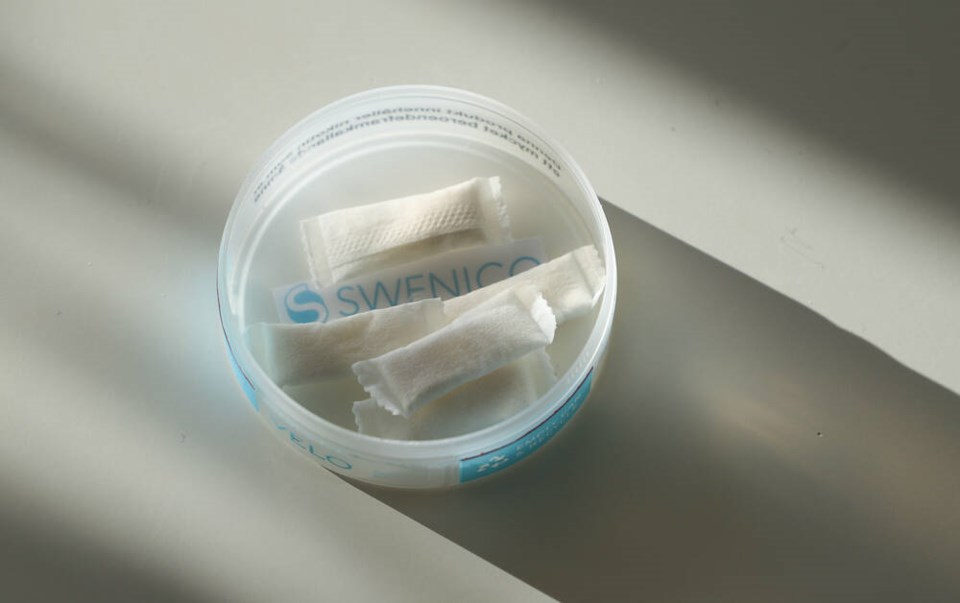A B.C. government order that flavoured nicotine mouth pouches be sold only from behind pharmacy counters to prevent youth from becoming addicted is a welcome move that complements prevention measures in schools, says a Saanich School District official.
“I’m happy to see measures in place to keep these products over the counter and out of arms reach of kids,” said Peter Westhaver, director of instruction.
The order signed by Health Minister Adrian Dix means buyers of the pouches, which contain up to four milligrams of nicotine, have to consult a pharmacist.
Westhaver said principals at the district’s biggest high schools haven’t had a problem with the nicotine mouth pouches, but there’s a continued uptick in youth vaping, another product that’s intended to help adults quit smoking but often ends up in the hands of youths who have never smoked tobacco.
Premier David Eby, who is expected to introduce legislation in the spring around vape products marketed to youth, said the province is doing what it can to prevent children from coming into contact with the “hazardous” and “addictive” tobacco pouches while Health Canada works to address loopholes that allowed them to be sold in convenience stores and gas stations.
Eby told a news conference that nicotine use can cause changes in the brain of young people, and the government wants to prevent youth from coming into contact with products whose flavours and marketing messages can appeal to children. “Whether we are talking about [nicotine] in cigarettes, in vapes, or in other products, we don’t want our kids to get hooked on nicotine and have a dependence on nicotine for their entire lives.”
The pouches, which come in a variety of flavours, are available under Imperial Tobacco Canada’s brand name Zonnic.
At a news conference about a cancer care clinic in Kamloops on Thursday, Dix said the packaging makes the nicotine pouches look like breath mints. “I heard people from Imperial Tobacco talking about their intent yesterday, and, obviously, they made it clear they don’t want young people to take it. Well, we don’t either.”
Smoking or vaping isn’t allowed on school grounds, said Westhaver, but while tobacco smoking is noticeable, vaping is easily concealed and done in school bathrooms, and nicotine pouches are no more noticeable than a wad of gum in someone’s mouth.
Youth typically start to push boundaries at ages 12 to 15 and take risks without a full understanding of consequences, said Westhaver. “They tend to think they’re invincible. So it’s not surprising that anything that looks tempting, teenagers are going to try. They’re going to be curious — that’s their nature — and so it can be challenging for parents and teachers when kids are experimenting and can be very discreet with these products.”
Dix said smoking-cessation products need to be targeted to those looking to reduce their dependency on nicotine, which affects memory and concentration and can alter brain development, reduce impulse control, and cause behavioural issues in children and youth.
Nicotine dependence can also result in withdrawal, and cause symptoms such as headaches, shakes, dizziness, and feelings of anxiety or depression.
Imperial Tobacco Canada said it is “extremely disappointed” by B.C.’s decision to move the sale of flavoured nicotine pouches behind pharmacy counters, saying shifting sales away from convenience stores and gas stations makes it “more difficult for smokers to access a product that can help them quit smoking.”
The Montreal-based company said it supports preventing children from buying nicotine products, and Imperial has “gone above and beyond” to make sure they’re only available after age verification.
The federal government licensed tobacco pouches as a natural health product but has since said that was done under a loophole it has vowed to close.
“I look forward to supporting their actions when they come and I expect them to come soon,” Dix said.
>>> To comment on this article, write a letter to the editor: [email protected]


